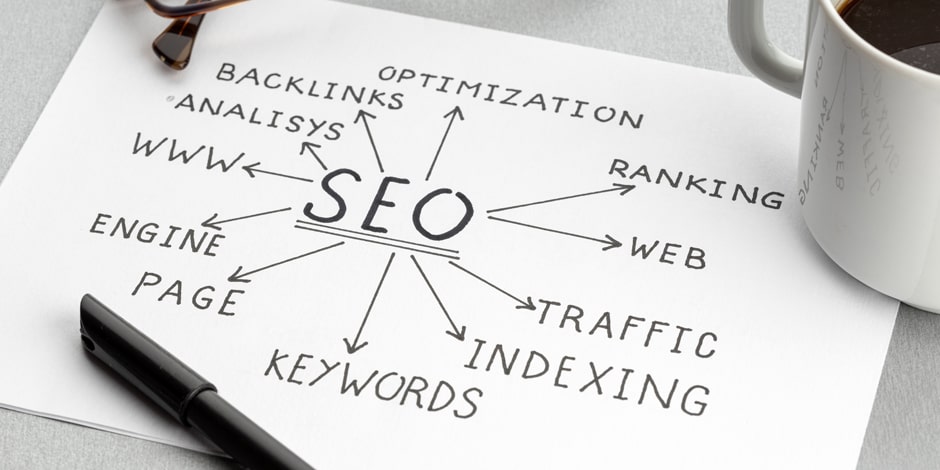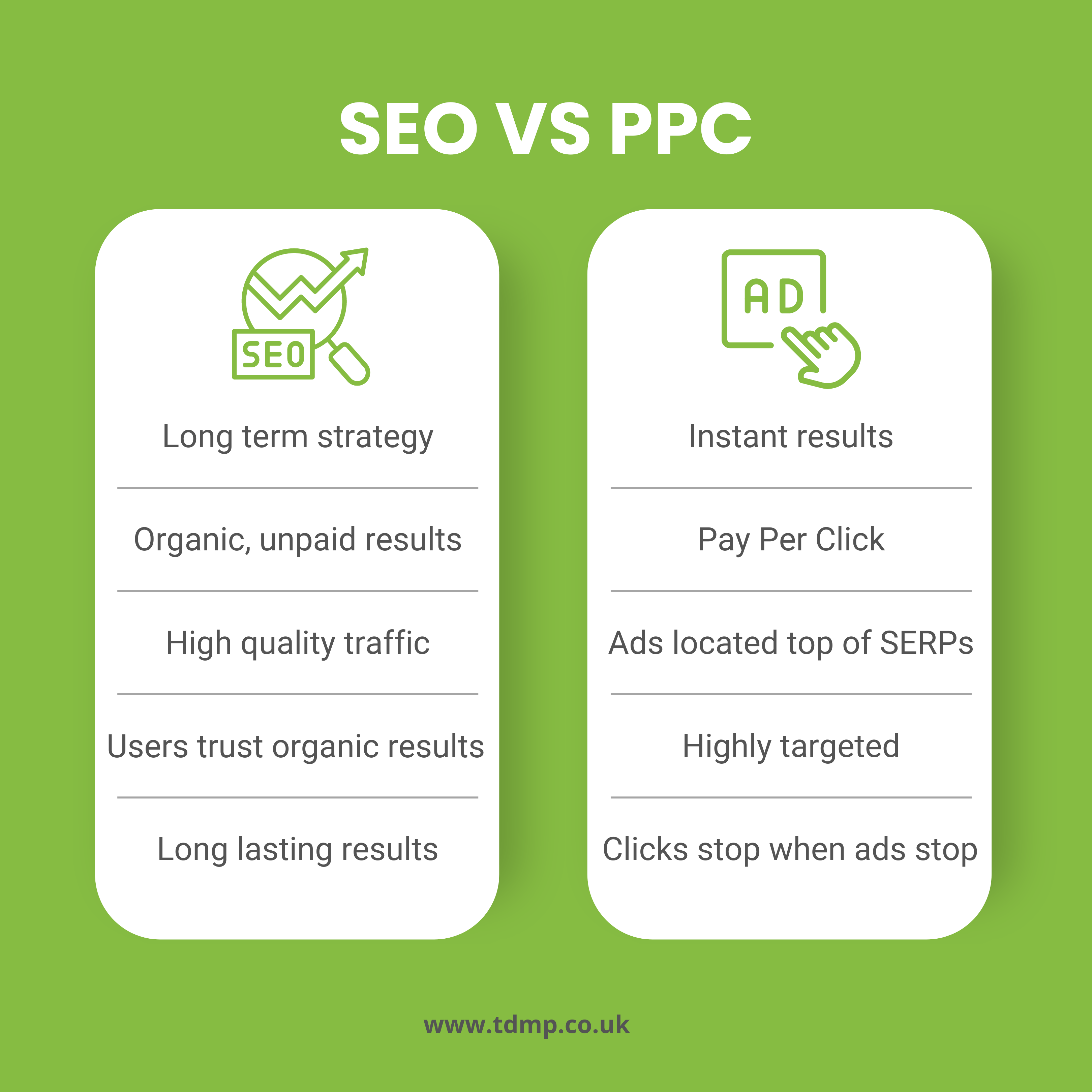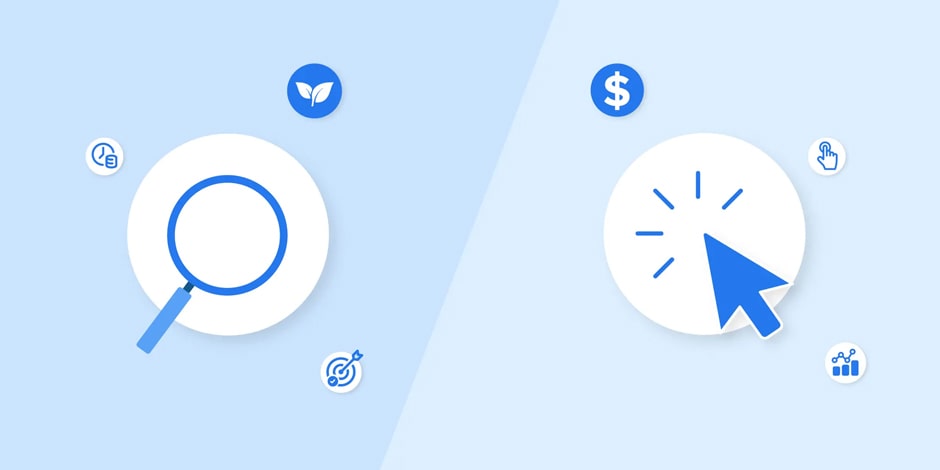Nowadays, the majority of people rely on the internet to find local businesses. In fact, over 90% of Americans use online search engines to locate services or products in their area. It is worth noting that about 94% of search engine users tend to click on organic results rather than paid ads. However, pay-per-click (PPC) advertising can generate twice as many website visitors compared to search engine optimization (SEO).
When it comes to increasing brand awareness, PPC has been shown to be highly effective, as it can boost brand recognition by up to 80%. However, SEO can also be a valuable tool for enhancing your website’s organic rankings and driving traffic to your site.
But what is the difference between SEO and PPC, and how do they differ in terms of their benefits and drawbacks? SEO focuses on optimizing your website and its content to rank higher in search engine results pages (SERPs) naturally, without paying for placement. In contrast, PPC is a form of paid advertising where advertisers pay each time a user clicks on their ads, which appear at the top of search engine results or on other websites.
While both SEO and PPC have their advantages and disadvantages, using both strategies can provide businesses with a more comprehensive approach to search marketing. SEO takes time and patience, but it can provide long-lasting results and improve your website’s organic rankings. Meanwhile, PPC can be a quick way to drive targeted traffic to your site, especially when you need immediate results.
Exploring the Concept of Search Engine Optimization (SEO)
- To put it simply, Search Engine Optimization (SEO) is a set of techniques and practices aimed at optimizing a website’s content to improve its visibility and ranking in search engine results pages (SERPs).
- When a user types in a search query, search engines like Google, Bing, or Yahoo will scan the internet for relevant content and provide a list of results based on their relevance to the search terms. By implementing SEO techniques, you can improve the chances of your website appearing at the top of these SERPs, increasing the visibility of your brand, and driving more traffic to your website.

The main goal of SEO is to make your website more visible and attractive to both search engines and users. This involves using various tactics, such as keyword research, content optimization, link building, and technical optimization, to create a website that is not only easy for search engines to crawl and index but also provides valuable information and a great user experience.
An effective SEO strategy can help you generate organic traffic, which is traffic that comes to your website from search engine results, rather than through paid advertising or other marketing channels. Organic traffic tends to be more valuable as it indicates that the user has shown genuine interest in your products or services and is more likely to convert into a customer.
In summary, SEO is a crucial aspect of any digital marketing strategy, as it helps businesses improve their online visibility, increase organic traffic, and ultimately drive more revenue.
- Building brand awareness and recognition
- Fostering brand trust and loyalty
- Establishing credibility in the market
- Driving website traffic organically
- Generating online leads and sales
- Achieving a better return on investment (ROI)
- Improving search engine rankings and visibility
Organic searches are a significant driver of website traffic, accounting for more than 53% of all traffic. To make the most of this potential traffic source, businesses need to develop an effective SEO strategy that covers different aspects of optimization.
A well-rounded SEO strategy should encompass four distinct types of SEO, which are:
The Types of SEO:
- On-page SEO – optimizing individual pages on a website for specific keywords and phrases to improve their ranking in search engine results.
- Off-page SEO – activities that take place outside of your website to improve its visibility and ranking, such as link building and social media marketing.
- Technical SEO – optimizing the technical aspects of a website to make it easier for search engines to crawl and index its content, such as improving site speed, mobile responsiveness, and schema markup.
- Local SEO – optimizing a website’s content and online presence to rank higher in local search results, making it easier for customers to find and visit a business’s physical location.
By considering these different types of SEO and implementing a comprehensive strategy, businesses can improve their online visibility, attract more organic traffic, and ultimately drive more leads and sales.

What Is PPC?
What is pay-per-click advertising, then?
While SEO is a form of organic search marketing, pay-per-click Management is a paid advertising strategy where businesses pay a fee each time a user clicks on their ads. These ads can appear on search engine results pages, social media platforms, or other websites.
Google Ads is a popular platform for creating PPC ads and allows businesses to target consumers based on the keywords they use during a search. With Google Ads, you can also use precise targeting to ensure your ads appear in front of your ideal customers.
For instance, you can target a specific radius around your storefront, as well as target users based on their age, gender, or other demographics. This precise targeting can help businesses maximize the impact of their PPC ads and ensure they reach the right audience at the right time.
Overall, PPC advertising can be a powerful tool for businesses looking to drive targeted traffic to their website, increase brand awareness, and ultimately generate more leads and sales. By combining PPC with other search marketing strategies like SEO, businesses can create a comprehensive digital marketing approach that delivers long-term results.
Different Forms of Pay-Per-Click (PPC) Advertising
- Google Ads offers various types of PPC ads, including text and display ads, that businesses can leverage to drive targeted traffic to their website.
- Text ads are typically displayed alongside organic search results on search engine result pages. In contrast, display ads can appear on various websites within Google’s Search Network and feature still images, animations, videos, and HTML-5 ads.
- In addition to text and display ads, businesses can create remarketing ads that target users who have previously visited their website. Remarketing ads provide businesses with an opportunity to reconnect with potential customers who have shown interest in their products or services in the past.
- By using remarketing ads, businesses can remind these potential customers of their brand and give them a second chance to convert into a lead or sale. Remarketing ads can be a powerful tool for businesses to maximize their ROI and drive more revenue from existing traffic.
Understanding the Distinctions Between SEO and PPC
- SEO and PPC are two different approaches to search engine marketing. SEO is an organic strategy, whereas PPC is a paid one. The most significant difference between the two is the time required to achieve results. SEO is a long-term strategy that takes time to improve organic rankings, whereas PPC can deliver immediate results.
- Another difference is the level of control over targeting. PPC allows for more precise targeting, while SEO relies on optimizing content and website structure to rank for relevant keywords. While SEO can provide long-term benefits, once a site gains a higher ranking, it may take a while before a competitor overtakes it. In contrast, with PPC, your ad placement is based on your bids, and the competition can quickly outbid you.

What is the Benefit of Using Both SEO and PPC Strategies?
Rather than choosing between PPC and SEO, it is recommended to utilize both strategies for optimal results.
PPC advertising can generate immediate traffic to your website while also catching the attention of Google and potentially improving your organic rankings. Additionally, appearing in front of webmasters through PPC advertising can lead to backlinks and increased domain authority.
Both strategies can also increase brand awareness, website traffic, and leads.
Focusing on SEO can also benefit your PPC campaigns by improving your landing page experience and therefore increasing your quality score and reducing cost-per-click. Furthermore, data from PPC campaigns can provide valuable insight into target keywords for SEO blog content.
By utilizing both search marketing methods, you can effectively expand your online reach.
Effective Search Engine Marketing Strategies: Incorporating SEO and PPC for Better Results
To maximize your online visibility and achieve greater success, it’s recommended to implement both SEO and PPC strategies in your search engine marketing plan. By doing so, you can reach a wider audience and increase your chances of generating brand awareness, website traffic, and sales.
Don’t feel overwhelmed if you’re unsure of where to start or how to develop a solid strategy. Our team of experts is here to help you every step of the way. We can provide guidance and support in creating an effective plan that suits your business needs.
By partnering with us, you’ll have access to industry-leading tools and techniques that can help you achieve your online marketing goals. Contact us today to learn more and take the first step towards expanding your reach online.







 Content Writing
Content Writing Video Marketing
Video Marketing Graphic Design
Graphic Design Lead Magnet Creation
Lead Magnet Creation Content Marketing
Content Marketing